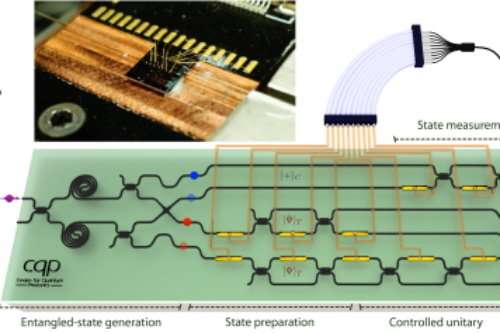New algorithm for simulating the structure of quantum systems on a quantum photonic chip

An international collaboration of quantum physicists from the University of Bristol, Microsoft, Google, Imperial College, Max Planck Institute, and the Sun Yat-sen University have introduced a new algorithm to solve the energy structure of quantum systems on quantum computers.
They have tested this algorithm on a silicon quantum photonic processor which performs the computation using photons, the elementary particles of light.
The energy structure of a quantum system is made of quantised energy levels, the lowest energy level is called ground-state, while the higher energy levels are called excited states.
In particular, this new algorithm is capable of finding the excited-states in a way that seems to have no direct analogue on a classical computer, providing a new way of studying physics and chemistry at the microscopic level.
Fundamental chemical and physical properties of systems can be characterised by finding a particular set of quantized states called eigenstates which contains the ground state of the system (the state with minimal energy) and excited states (stationary states with higher energies).
Author Jarrod McClean, from Google's Quantum AI Lab, said: "Expanding the toolkit for excited states is crucial if we want quantum computers to make meaningful contributions to important areas such as solar cells and batteries."
It is expected that large quantum computers will be able to simulate complex chemical systems, a task impossible for classical computers, increasing our knowledge of physics and chemistry.
The research, published today in the journal, Science Advances, was led by researchers from the University of Bristol's School of Physics.
Lead author Dr Raffaele Santagati said: "In this work we provide a new tool for studying the properties of quantum systems with quantum computers."
This goal is achieved by introducing an approach to quantum simulation based on the novel concept of "eigenstate witness", a quantity which detects whether a given quantum state is close to an eigenstate of the system or not.
Dr Jianwei Wang, also from University of Bristol, added: "We successfully tested the protocol for a proof-of-concept case in a silicon quantum photonic chip, showing its applicability to simulate more complex systems in realistic short-term quantum devices."
Shortly after the Bristol demonstration, another approach has been experimentally demonstrated by Dr Jeremy Colless and colleagues from the UCA in Berkeley, using superconducting qubits.
The researchers foresee that the key findings of this paper will foster research towards improvements in the proposed algorithm and the rise of new applications.
Advanced quantum computers will unlock powerful applications, and this is expected to be possible within the next few decades, when quantum computers with approximately 200 qubits will be available.
Dr Santagati added: "Further development of integrated quantum photonics, realising more complex devices, will make possible more useful photonic quantum simulators."
More information: Raffaele Santagati et al. Witnessing eigenstates for quantum simulation of Hamiltonian spectra, Science Advances (2018). DOI: 10.1126/sciadv.aap9646 , arxiv.org/abs/1611.03511
Journal information: Science Advances
Provided by University of Bristol





















